Rules for CONGESTION
Contents:
- TYPE OF GAME
- OBJECT OF THE GAME
- EQUIPMENT USED
- RACKS (Head, Center, and Foot)
- DETERMINING PRIVATE NUMBERS
- SCORING
- OPENING BREAK
- RULES OF PLAY
- WHAMMY BALLS
- STICKING THE TABLE
- BALLS OWED
- JUMPED CULL BALL
- JUMPED OBJECT BALLS
- JUMPED WHAMMY BALL
- SPOTTING BALLS
- PENALTY FOR FOULS
TYPE OF GAME
The game was developed by some Billy Aardd's Club members on a boring
summer afternoon. Except when clearly contradicted by these
additional rules, the General Rules of
Pocket Billiards apply.
OBJECT OF THE GAME
(To kill time and have some fun. People may drop in and out of
the game if the other players are okay with it. This may be
dangerous though as it opens the door for week long tag-team
games weaved around classes!)
To score points which, when added to the player's private number (a
Kelly pea), total exactly that matching the required final score.
The final scores for various number of players are given
below:
2 - 276 7 - 106
3 - 196 8 - 96
4 - 156 9 - 76
5 - 136 10 - 76
6 - 116
EQUIPMENT USED
Balls from several games are used in this game. All balls are
2.25" diameter.
- Two cue balls. The cue ball at the top of the foot rack
is a "crazy" cue ball (its center of mass is off-center so that
it wiggles and curves when moving).
- Two sets of balls numbered 1 through 15, minus the 8-balls.
- Three "crazy" 8-balls.
- One set of balls numbered 1 through 21 (a baseball set).
- One set of 2.25" diameter snooker colors (numbered 2 through
7). (These are the whammy
balls.)
A shake bottle with 15 (Kelly) peas (numbers 1 through 15).
Paper and pencil to tally the various things that will require
tallying.
For example:
- number of whammy balls sunk,
- number of consecutive innings fouled in,
- who owes what to whom.
Places, or things, where each player can keep the balls he has gathered
(through legal shots or whammy-actions). Also known as a
player's "ball stash".
RACKS
An example from a 10-foot Gandy "Big-G" pocket table.
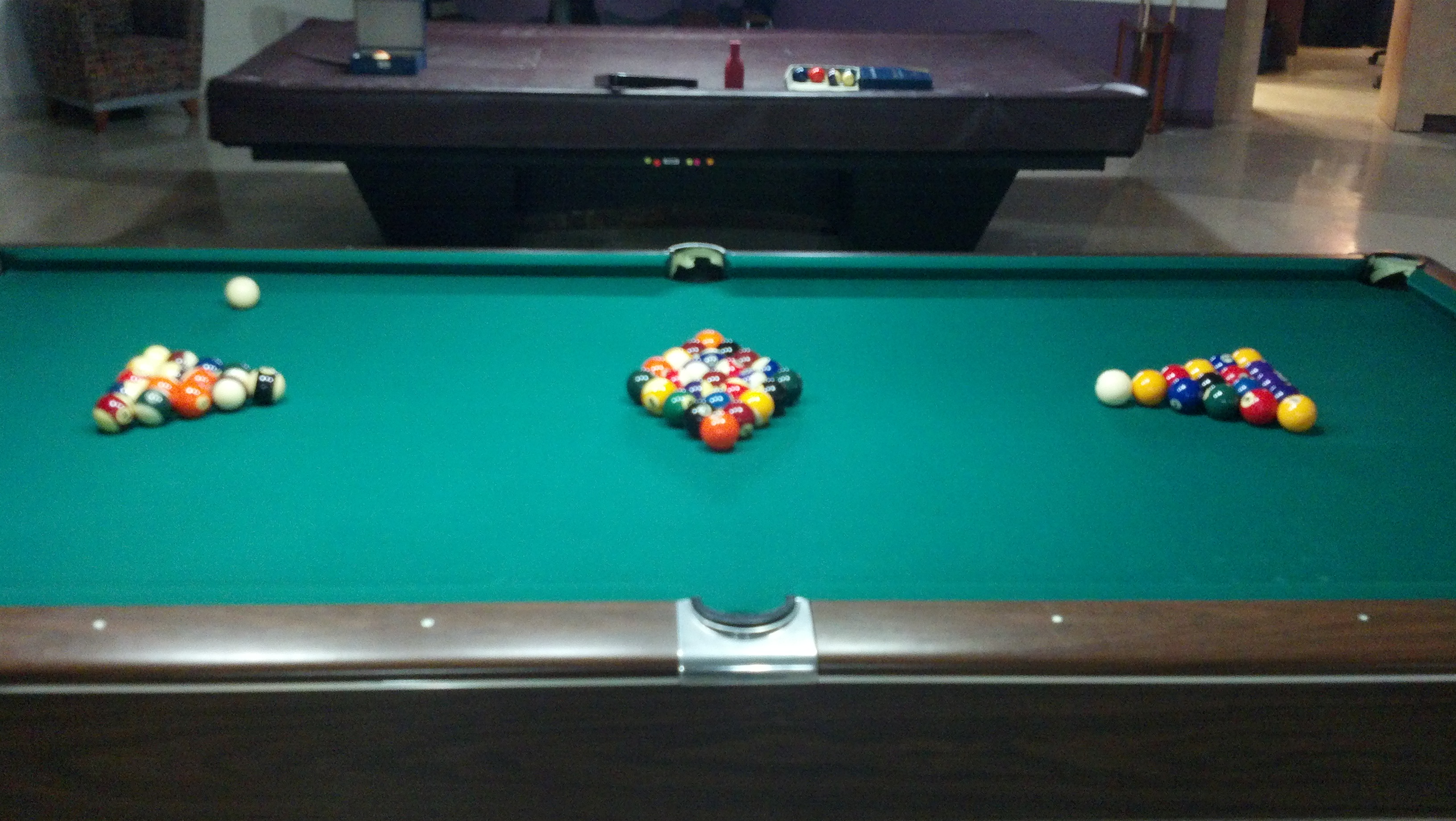
- Foot rack -
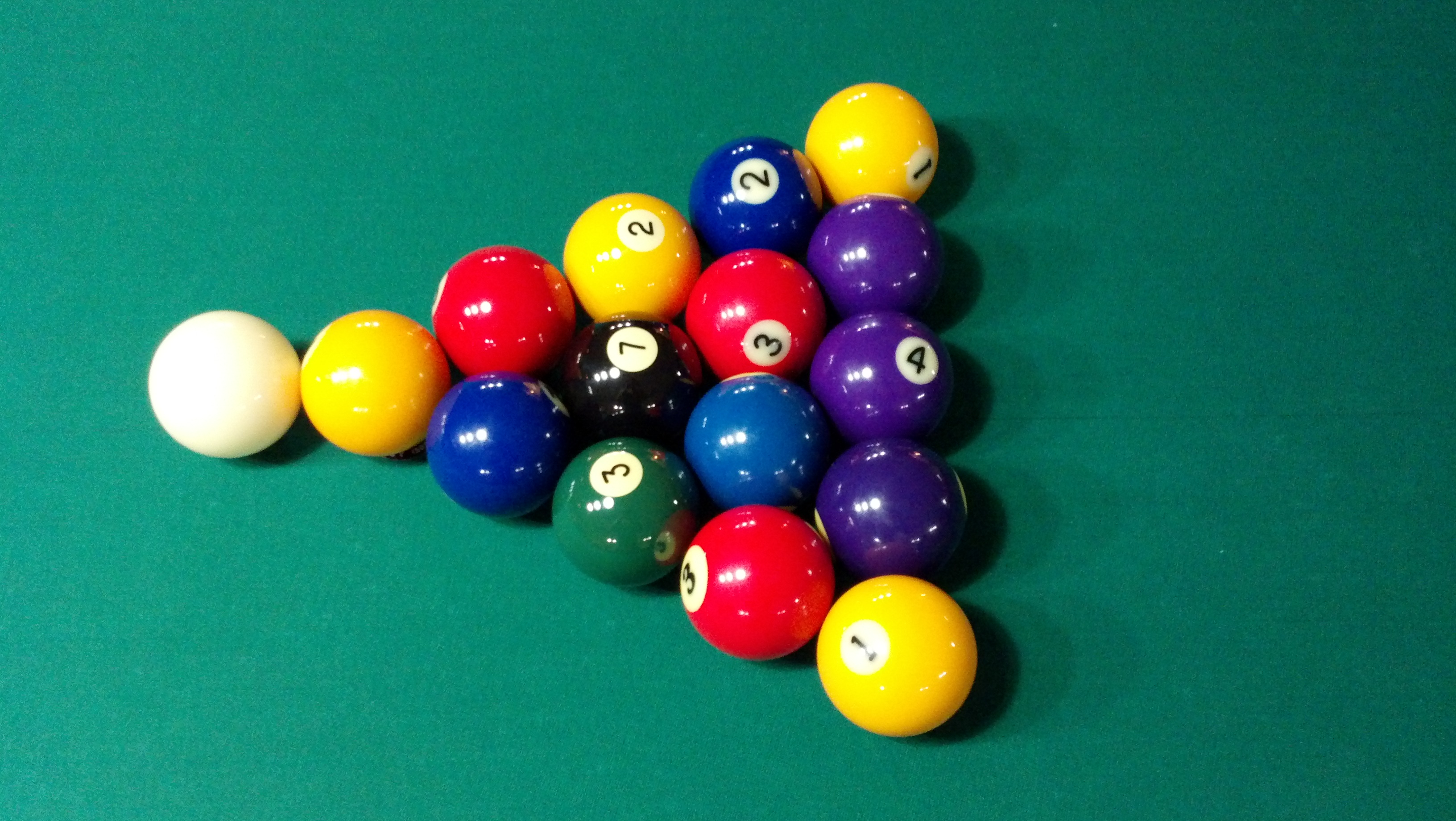
A standard triangle rack containing the numbered balls 1
through 4, along with the YELLOW (2), BLACK (7), and GREEN (3)
whammy balls. The whammy balls are placed in the third row of
the rack, with the black whammy in the middle. The apex
ball is on the foot spot and the crazy cue ball is placed
touching the apex ball on the center line of the table.
- Center rack - (note the "snooker"-4 pictured should be a
"snooker"-6, for the whammy ball)
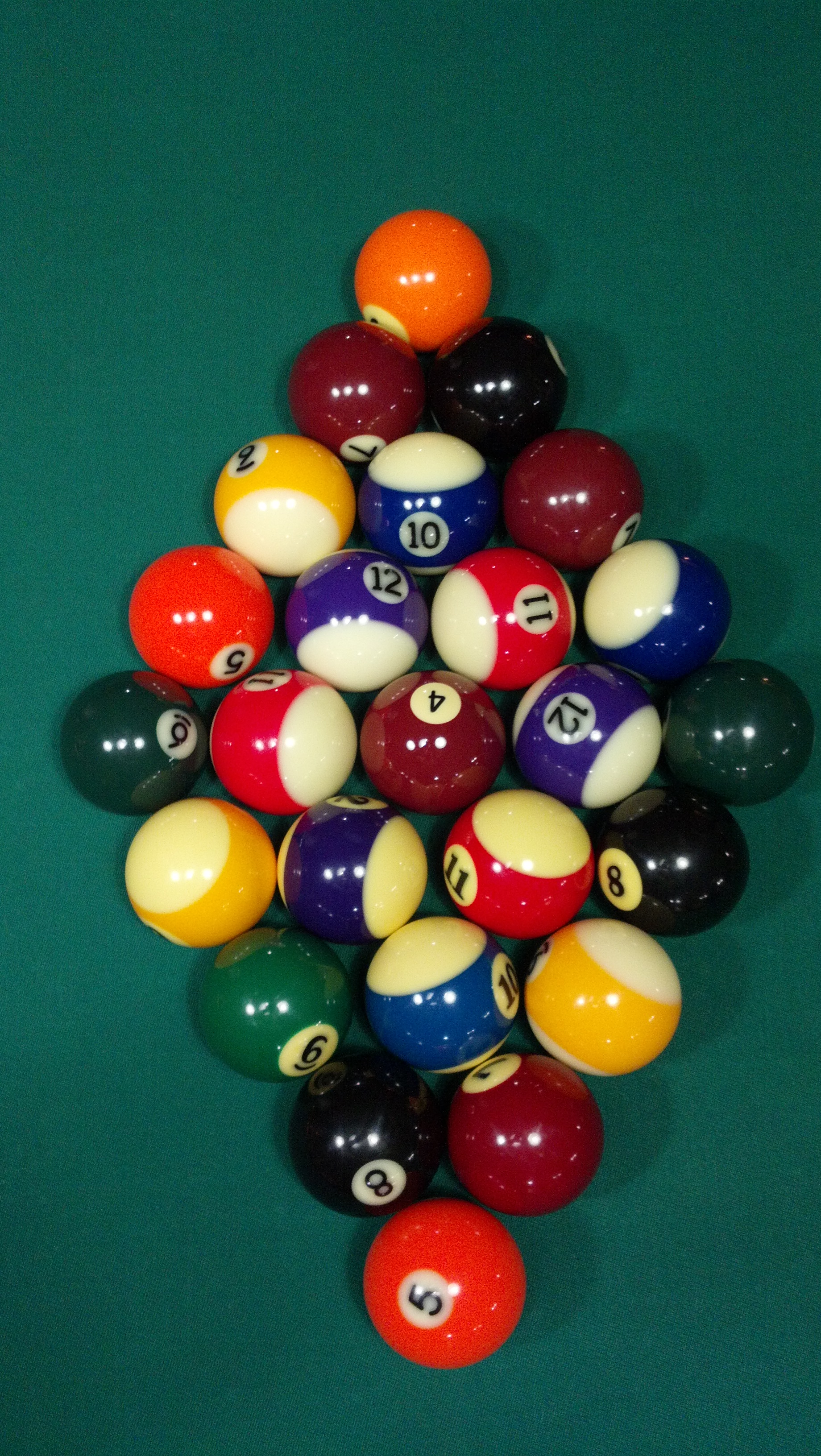
A large diamond rack, with its long axis between the side
pockets, centered on the center spot. It contains the numbered
balls 5 through 12, and the ORANGE (6) whammy ball. The orange
whammy ball is racked on the center spot.
- Head rack - (note the "snooker"-6 pictured should be a
"snooker"-4 {which is MAROON in our set, instead of BROWN}, for
the whammy ball)
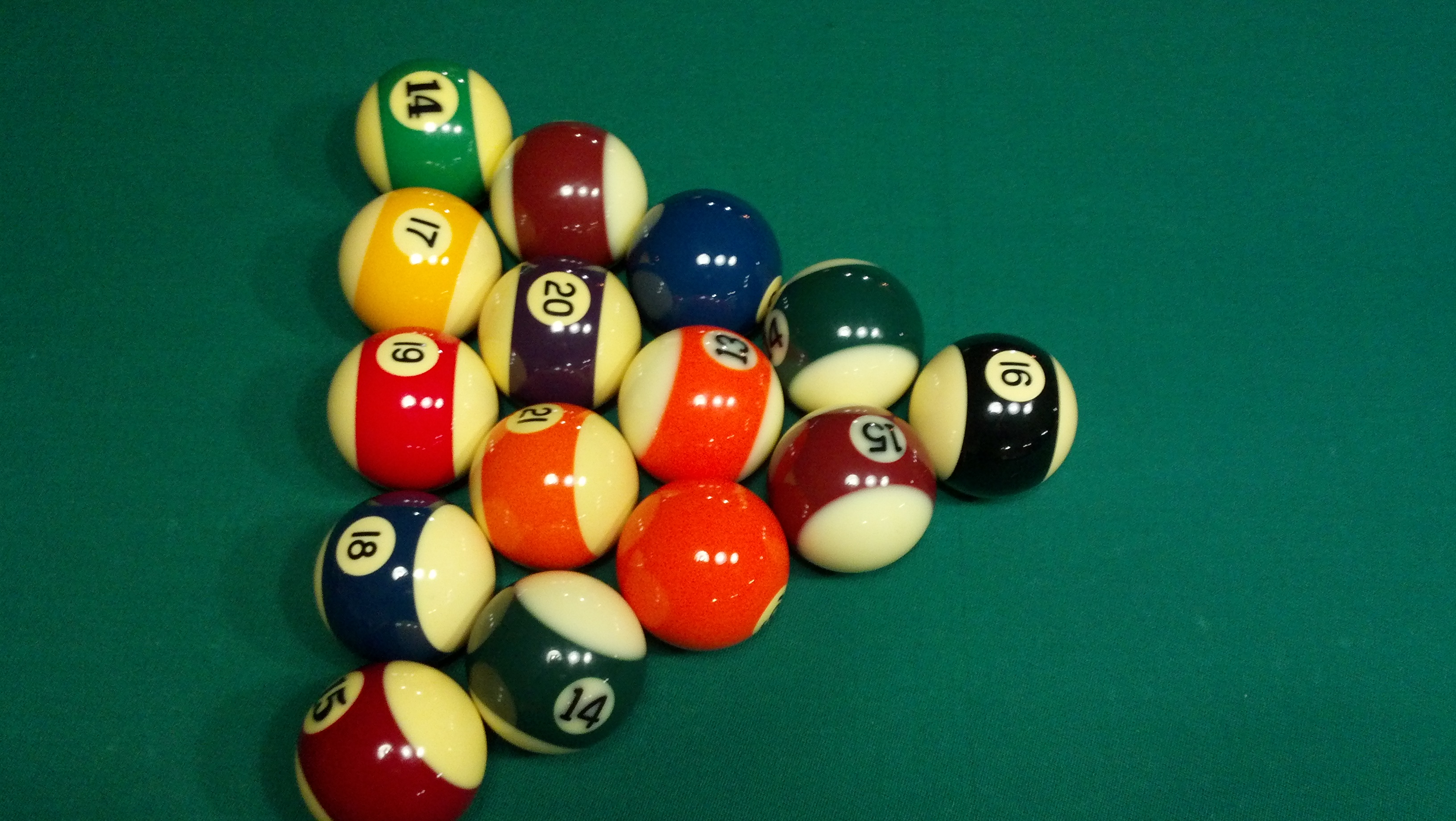
A standard triangle rack containing one 13 ball, the balls
numbered 14 through 21, along with the BLUE (5) and MAROON (4)
whammy balls. The whammy balls are placed in the third row of the
rack with the 13 ball between them. The bulk of the head
rack is behind the head string.
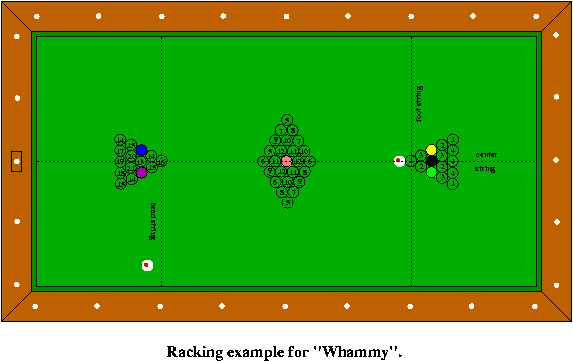
NOTE: The PURPLE whammy shown in the head-rack is the Snooker
4-ball
(now MAROON or BROWN).
NOTE II: The cue ball in the "kitchen" (behind the head string) is
the only one that can be used for the opening break.
The player
opening the game can place it anywhere in the kitchen.
ALSO NOTE: The game is played on a pocket table
(pockets need to be added to the racking diagram!).
DETERMINING PRIVATE NUMBERS
After the balls are racked but before play begins, each player draws a
pea from the shake bottle containing the peas numbered 1 through 16. The
number of the pea is the player's private number and is kept secret.
It is used in tallying for game points.
SCORING
Each legally pocketed non-whammy ball has a point value equal to its
number. Each whammy ball invokes a special rule
(action) as described below.
OPENING BREAK
Breaker is determined by drawing peas before the balls are racked.
The order of players is according to pea value - the lowest to
highest. The order of players is kept and the peas are returned
to the shaker bottle for drawing of private numbers later.
The break must be an open break (at least four object balls must reach
a cushion).
The starting player must shoot from the kitchen and contact an object
ball of the foot rack first, failure to do so is
a foul. NOTE: The cue ball is not an
object ball and so having a cue ball's first contact be with the other
cue ball is a foul.
RULES OF PLAY
- Any ball(s) scored on a legal stroke count for the shooter.
Players may shoot any ball, with either cue ball (except
on the opening break), and need not call ball,
pocket, or mode of shot.
- A player is permitted at most 2 strokes per inning. The
second stroke is only allowed if the first was a legal count.
Options: (these need to be decided before play
begins)
- Counting on the first stroke is not required in order to
take the second stroke, i.e. everybody always gets
two shots per turn if this option is taken.
- Each player declares before the first shot of their
inning how many points they will score and how many
balls they will pocket to do it. If they are off
by more than five points they will be allowed to remove
a ball of their choosing (which would spot) to adjust
that total. If they still fail to meet their
point prediction all the balls they sank that inning
will spot and their inning is over. This
tallying excludes any balls involved in whammy
transactions, and so the balls sank in their inning can
not take part in any whammy transactions.
If they have met their prediction they can have one more
stroke to sink any object balls. If a whammy is
sunk it will be a foul, no whammy-action will take
place, and the whammy ball will spotted as close to it's
pre-break (start of the game) position as possible.
- Any illegally pocketed (non-whammy) balls do not count for the
shooter, and are spotted. Whammy
balls are considered pocketed (with the exception of option
#2 above) whether or not the stroke was legal.
- When any whammy ball is made on a stroke,
the inning is not over until the action required by the
whammy ball is completed. To ensure that no other
action takes place until whammy transaction(s) complete the
shooter must stick the table.
- When a player has pocketed their fourth whammy ball, and the
whammy-action has been completed, the player is out of the
game. (See WHAMMY BALLS for more details
on this.)
- On all shots, a player must cause a cue ball to contact an
object ball and then either (1) pocket an object ball, or (2)
cause an object ball or the cue ball to contact a
cushion. Failure to do so is a foul.
NOTE: The cue ball is not an object ball and
so cue-ball – cue-ball contact alone won't meet the
requirements of a legal shot.
- When a player is playing from the kitchen (following a scratch),
the affected cue ball(s) must be placed behind the head string.
The player may shoot either cue ball but if the chosen
cue ball is played out of the kitchen it must pass the head
string before contacting an object ball. Failure to do so
is a foul. If all of the object balls
are behind the head string, the object ball nearest the head
string may be spotted (shooter's option).
- When a player has a total count (the sum of numbers on the balls
he has sunk added with the value of his private pea) equal to the
score required for game, he must announce his victory and present
his balls and pea for confirmation prior to the next player
shooting. Player can only declare his win during his
turn. If he fails to declare his total until the next
player has shot, he must wait until his next turn to so declare.
If, in the meantime, another player succeeds in attaining
a legal final score and properly declares, the latter player wins
the game.
- If a player totals more than the final score, he has
busted, and must so declare immediately (before next
player shoots). All balls the busted player had
pocketed are spotted, and the busted player may draw a
new pea prior to his next turn. Any player who goes
over and does not declare it prior to the following player's
shot is disqualified from the game (and all their balls must be
spotted).
- If all the numbered balls are pocketed prior to any player
attaining the final score, the player whose total count is
highest wins the game. In case of a tie the person with
the pea closest to the eight pea will win. In case there
is a tie there the person with the most balls will win (and if
there's a tie there then flip a coin).
WHAMMY BALLS
- At the end of a whammy transaction (just before the table is
un-sticked) the pocketed whammy ball(s) are re-positioned
by the shooter anywhere on the table, but not within the jaws of
a pocket or frozen to any other ball(s).
A player is not allowed to count on any whammy ball he positioned
(from a whammy transaction) in the same inning. If such a
whammy ball is sunk it will not count and the person who shot
prior to the shooter will re-position it.
- All pocketed whammy balls count (whether the stroke was legal or
not).
- YELLOW whammy
(snooker 2 ball) -
When a player pockets the
yellow whammy ball, the player will give one ball (balls in
descending order of value) to each of the other players in order
of succession, starting with the player following him. If
the player does not have enough to give each opponent a ball, he
owes the remaining players one ball each.
- GREEN whammy
(snooker 3 ball) -
When a player pockets the
green whammy ball, the player will give one ball (balls in
descending order of value) to each of the other players in
reverse order of succession, starting with the player before him.
If the player does not have enough to give each opponent a
ball, he owes the remaining players one ball each.
- MAROON whammy
(snooker 4 ball,
sometimes BROWN) -
When a player pockets a maroon whammy ball, all players except
the person pocketing the maroon whammy will return their peas to
the bottle and then draw a new pea according to shooting order.
Any person who would go over at the end of the transaction
may return up to three balls, not totaling over twenty points, to
the table.
- BLUE whammy
(snooker 5 ball) -
When a player pockets a
blue whammy ball, the player exchanges one ball of his choice
with each opponent in order of succession, starting with the
player following him. Each opponent may choose which ball
he will exchange. The chosen balls will remain hidden
until exchange takes place. If a player has no balls, no
exchange will take place. The player may also re-position
one other whammy ball.
- ORANGE whammy
(snooker 6 ball,
sometimes PINK) -
When
a player pockets a orange whammy ball, the player will receive
the highest numbered ball of each opponent. If an
opponent has no ball, the opponent owes the player his highest
numbered ball. The player may also re-position up to two
other whammy balls.
- BLACK whammy
(snooker 7 ball) -
When a player pockets a
black whammy ball, the player will receive a ball of his choosing
from each opponent. If an opponent has no ball to take
then nothing will be owed. The player may also re-position
up to three other whammy balls.
- If a player pockets two or more whammy balls on a stroke, the
whammy-action will take place in the order of yellow (2), green
(3), maroon (4), blue (5), orange (6), then black (7).
- This rule applies when more than one transaction is being
conducted at the end of a player's turn. A player can
not be considered busted until all pending whammy
actions are completed. A player who goes over during one
whammy transaction and then returns under (at the end of a
subsequent transaction) will not be considered to
have busted.
- After a player has pocketed whammy balls four times, and the
whammy-action has been completed, the player is out of the
game. If the player has gone out on
the yellow or
green whammy
ball, the distribution of the player's balls will continue
until all his balls are gone. If the player has gone
out on any other whammy ball the player must spot his remaining
balls and all his debts are canceled. NOTE: This
may cause other players to bust!
STICKING THE TABLE
To prevent the next player from shooting before a whammy transaction is
completed the person who pocketed the whammy ball must stick the
table. This is done by (carefully) laying their stick on the
table. If any balls are touched while sticking the table it is a
foul and the penalty for a foul must be paid after the
whammy transaction is completed.
BALLS OWED
Balls are owed in the order in which the debt is occurred. Debts
must be paid as soon as balls are available. (Example: If Ed is
owed a ball by Joe, and Ed owes a ball to Tom, then when Joe gets a ball
he will give it to Ed who will then pay Tom.) Note that the
table can also be owed due to scratches or fouls (paying the table
comes before paying players).
JUMPED CULL BALL
Is a scratch and player must pay the foul penalty.
Incoming player has the affected cue ball(s) in hand behind the head
string. Cue ball(s) can't be placed in jaws of a pocket.
JUMPED OBJECT BALLS
Is a scratch and player must pay the foul penalty.
The jumped object ball(s) will be spotted.
JUMPED WHAMMY BALL
Is to be considered a pocketed whammy ball. The table must be
sticked (see: Sticking the Table) for the
resulting whammy transaction.
SPOTTING BALLS
If the center line of the table is filled, the balls are spotted along
foot string, as close to the foot spot as possible. If the
distance from the foot spot is equal on both sides the ball will be
spotted on the right. Balls are spotted in ascending order of
value.
PENALTY FOR FOULS
The player committing a foul must spot one of his previous scored balls
for each foul committed. If a player fouls and pockets a whammy
ball on the same stroke, the foul penalty is completed before the whammy
action. If a player fouls in three consecutive innings, he is
out of the game (after pending whammy-action) and must spot all his
balls, his remaining debts are canceled.
These rules are used by Billy Aardd's Club, NMIMT, Socorro, NM.
Copyright 1996 by Billy Aardd's Club.





